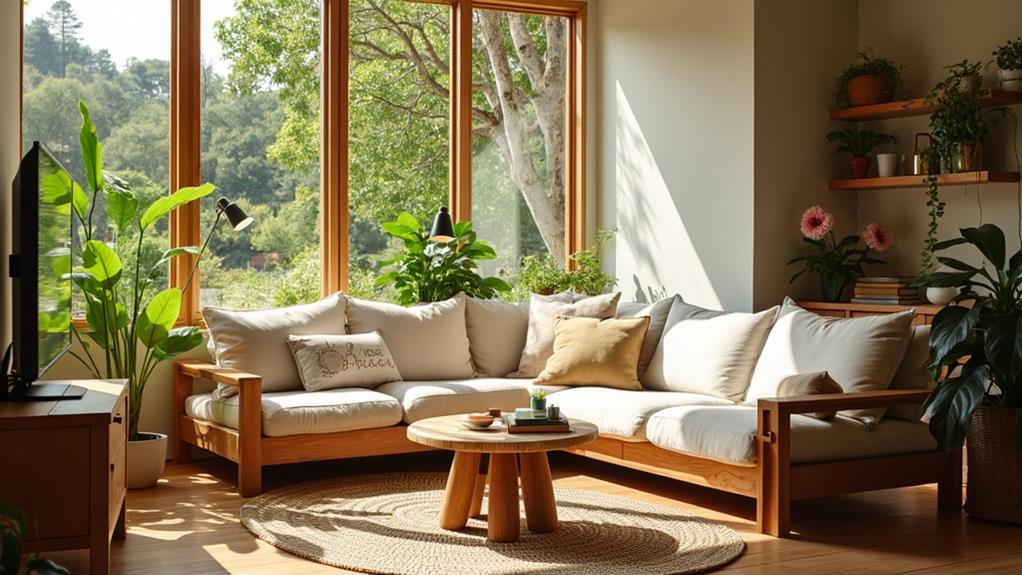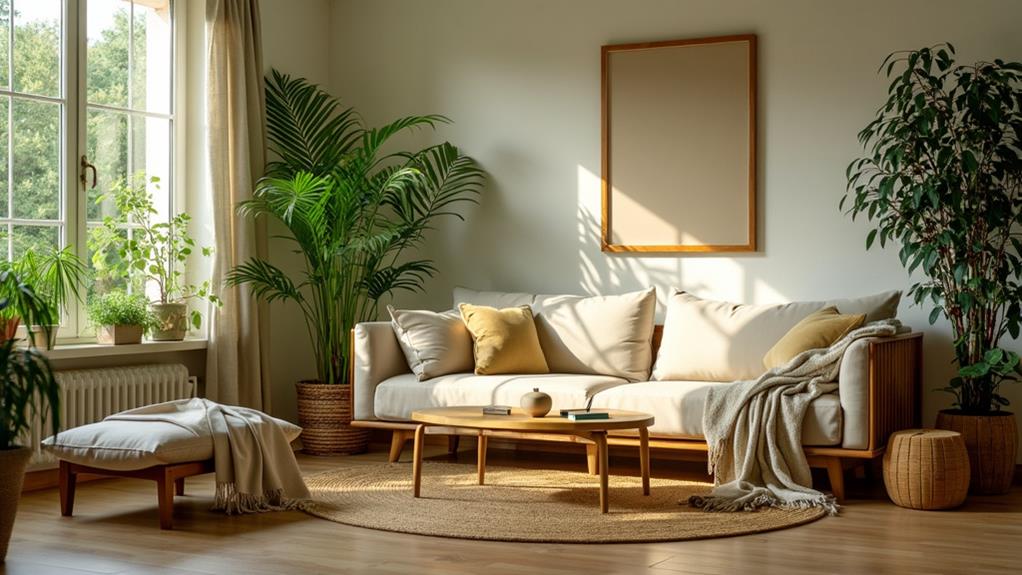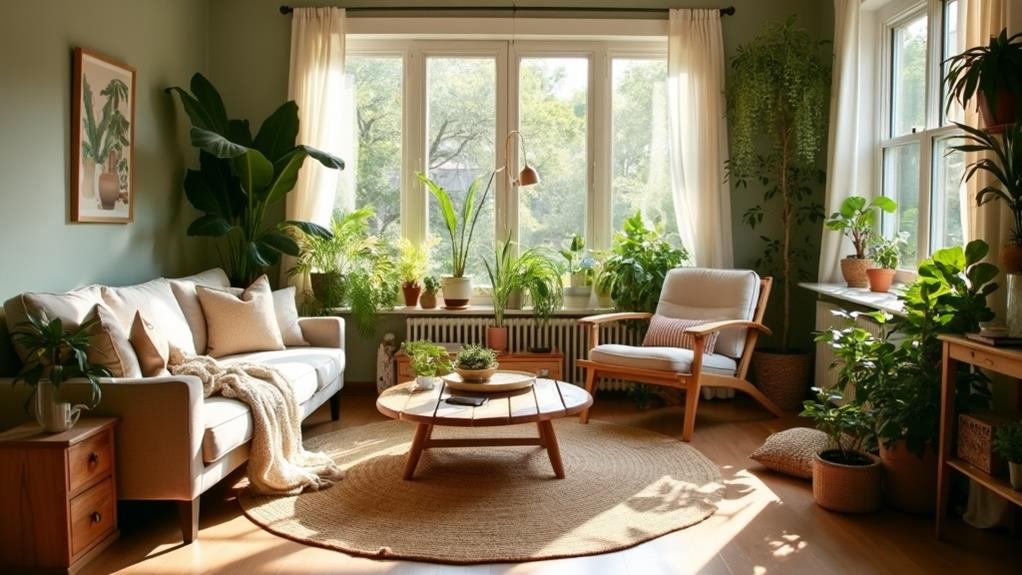Creating an eco-friendly and comfortable home entails selecting sustainable materials like bamboo, reclaimed wood, and organic cotton, which not only reduce our environmental impact but also promote health. Our furniture choices should balance comfort, style, and ergonomics to guarantee proper posture and reduced strain. Durable materials, such as metal and solid wood, extend the life of our furnishings and decrease landfill waste. Additionally, energy-efficient appliances and proper insulation lower utility costs. By focusing on these aspects, we can build a home that supports well-being and sustainability, and if we follow these principles, we can explore even more effective strategies.
Importance of Eco-Friendly Furniture

Choosing eco-friendly furniture is an essential step in creating a sustainable home. When we select pieces made from renewable or recycled materials, we greatly reduce our environmental footprint. Eco-friendly furniture often utilizes sustainably harvested wood, reclaimed materials, and non-toxic finishes, all of which contribute to preserving natural resources and promoting healthier indoor air quality.
Pieces like the French Style Deep Button Chair add classic aesthetics while being mindful of the environment. By opting for these alternatives, we support responsible manufacturing practices and help mitigate the adverse impacts of deforestation and pollution.
Moreover, eco-friendly furniture tends to be more durable and long-lasting, which means fewer replacements over time and less waste ending up in landfills. The production processes for such furniture often emphasize energy efficiency and minimal waste, reflecting a commitment to sustainability at every stage.
Additionally, many eco-friendly pieces are designed with timeless aesthetics, ensuring they remain stylish and functional for years to come.
Incorporating eco-friendly furniture into our homes also sets a positive example for others, encouraging a broader shift towards more sustainable living practices. As consumers, our choices can drive demand for greener products and influence the market to prioritize environmental responsibility.
Identifying Comfortable Options
When identifying comfortable options for eco-friendly furniture, it's crucial to balance sustainability with personal comfort and style. We need to take into account several factors, including ergonomics, design, and the overall feel of the furniture.
Ergonomics is particularly important for items like chairs and sofas, which should support proper posture and reduce strain. Look for adjustable features or customizable options that cater to individual needs.
Design shouldn't be overlooked either. Aesthetics contribute greatly to how comfortable we feel in a space. Opt for pieces that seamlessly integrate with our existing décor, enhancing the room's ambiance. Additionally, reflect on the furniture's tactile qualities; fabrics should be soft yet durable, and cushioning should offer both support and comfort. Consider the variety of stain finishes available when choosing solid wood furniture to match your interior style.
We also need to think about the practical aspects of maintenance. Eco-friendly furniture can be easy to clean and maintain, guaranteeing it remains a comfortable and inviting part of our home for years.
Sustainable Material Choices

Sustainable material choices lie at the heart of creating an eco-friendly home. When we focus on materials that are renewable, recycled, or responsibly sourced, we greatly reduce our environmental footprint. Let's explore some of the most sustainable materials available and their benefits.
| Material | Source | Benefits |
|---|---|---|
| Bamboo | Renewable plant | Fast-growing, minimal pesticides |
| Reclaimed Wood | Salvaged from old sites | Reduces waste, unique aesthetics |
| Organic Cotton | Grown without chemicals | Eco-friendly, biodegradable |
| Cork | Harvested from cork oak | Renewable, durable, recyclable |
| Recycled Metal | Repurposed scrap metal | Conserves natural resources |
Bamboo is a standout for its rapid growth and minimal pesticide use, making it a highly renewable resource. Reclaimed wood, salvaged from old buildings or furniture, offers a unique aesthetic while reducing waste. Organic cotton, grown without harmful chemicals, is both eco-friendly and biodegradable, making it a superior choice for textiles. Cork, harvested sustainably from cork oak trees, provides durability and is recyclable. Finally, recycled metal, made from repurposed scrap, conserves finite natural resources, making it an excellent option for fixtures and furniture.
Durability Factors
Over time, the durability of materials becomes a critical aspect to contemplate in creating an eco-friendly home. When we choose durable materials, we guarantee that our investments last longer, reducing the need for frequent replacements and the associated environmental impact. For instance, opting for hardwood flooring instead of laminate can mean fewer replacements over decades, as hardwood can be refinished multiple times to maintain its appearance and integrity.
We should also consider how well materials withstand various conditions. Some materials, like natural stone or metal roofing, offer exceptional longevity and resilience against weathering. By selecting materials that resist wear and tear, we not only enhance the lifespan of our home components but also decrease the waste generated from frequent renovations.
One example is choosing solid wood dining room pieces that feature stain finishes to enhance durability and natural beauty.
Additionally, the maintenance required for different materials impacts their sustainability. Low-maintenance options, such as composite decking and fiber-cement siding, demand fewer resources for upkeep, contributing to their overall eco-friendliness.
Health and Cost Benefits

Creating an eco-friendly home doesn't just benefit the environment; it also offers significant health and cost advantages. By choosing sustainable materials and practices, we reduce exposure to harmful chemicals often found in traditional building products. For example, opting for low-VOC (volatile organic compounds) paints and finishes minimizes indoor air pollution, leading to better respiratory health and fewer allergy symptoms.
Additionally, using natural fibers for carpets and upholstery decreases the likelihood of skin irritations and other health issues related to synthetic materials.
From a financial perspective, eco-friendly homes can lead to substantial cost savings over time. Energy-efficient appliances and systems, such as LED lighting, solar panels, and high-efficiency HVAC units, reduce utility bills due to their lower energy consumption.
Additionally, proper insulation and double-glazed windows maintain a stable indoor temperature, decreasing the need for excessive heating or cooling. The initial investment in these green technologies might be higher, but the long-term savings on energy costs can be significant.
Moreover, many governments offer tax incentives and rebates for eco-friendly home improvements, which further offset initial costs. By investing in sustainable choices, we not only create healthier living spaces but also guarantee financial savings that benefit us in the long run.

